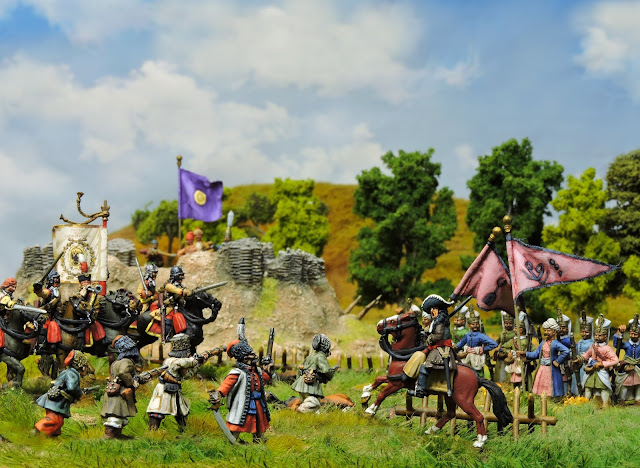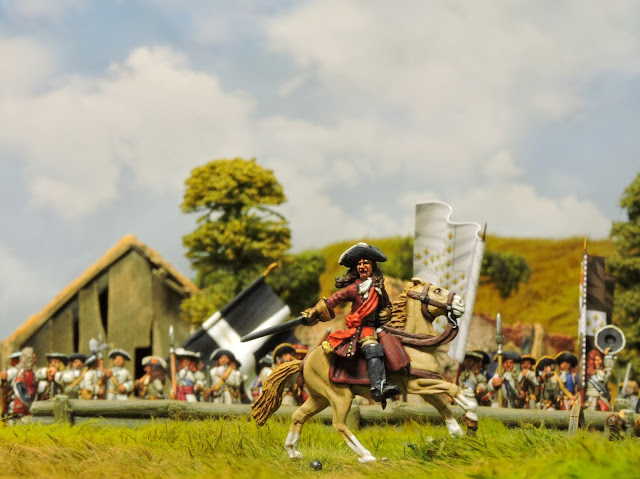The second part of my piece on Lord John Cutts of Gowran.
An appraisal of England’s fire eating general
 |
| English hero - for sure, Subject of Swiftian satire - definitely! |
What he did best
His speciality was leading assaults into the breach. Many of
his wounds were received in such situations. He seemed to gravitate towards peers
and superiors with a similar disposition to his own. One such, Thomas
Tollemache, a rival of John Churchill and another fire-eater, died after being
hit in the groin by a cannonball during the disastrous Camaret Bay amphibious
landing. Cutts himself performed insanely reckless feats there yet, lived to
tell the tale.
Being point-man or any man for that matter, during the storming of a breach was generally recognized as a suicide mission. It was a task normally assigned to an army’s biggest, baddest head-bangers – the grenadiers. Tooled up with flintlock muskets, bags of hand grenades, hatchets, occasionally bedecked in armour and probably emboldened by copious quantities of Dutch gin or brandy, these lads would run out across the no man’s land between the besieger’s trenches and the shattered wall or gate section with the intention of driving all before them. The incoming fire was invariably a blended hail of musketry, canister shot and grenades. Against even moderately determined opposition the survival rates were depressingly low. The officers coordinating these attacks very seldom survived. Notwithstanding, Cutts participated in at least four and possibly as many as six such traumas. During the failed assault at Limerick in September 1690, Williamite losses of 2,000-3,000 men sustained in only a few hours fighting at a single breach, were nearly three times as heavy as Jacobite losses at the much more famous Battle of the Boyne. This Jacobite triumph is relatively unknown although a man of Cutts’ undisputed bravery would have recognized the ferocity and valour of the Jacobite defenders. The heroic French officer who led the resistance died. The indestructable Cutts, badly wounded and in the thickest of the fighting, crawled from the heaps of dead which clogged the breach like a dam.
Cutts the man
 |
| Man on the make - Cutts at 24 leading Transylvanian locals against the hated Turks |
Being point-man or any man for that matter, during the storming of a breach was generally recognized as a suicide mission. It was a task normally assigned to an army’s biggest, baddest head-bangers – the grenadiers. Tooled up with flintlock muskets, bags of hand grenades, hatchets, occasionally bedecked in armour and probably emboldened by copious quantities of Dutch gin or brandy, these lads would run out across the no man’s land between the besieger’s trenches and the shattered wall or gate section with the intention of driving all before them. The incoming fire was invariably a blended hail of musketry, canister shot and grenades. Against even moderately determined opposition the survival rates were depressingly low. The officers coordinating these attacks very seldom survived. Notwithstanding, Cutts participated in at least four and possibly as many as six such traumas. During the failed assault at Limerick in September 1690, Williamite losses of 2,000-3,000 men sustained in only a few hours fighting at a single breach, were nearly three times as heavy as Jacobite losses at the much more famous Battle of the Boyne. This Jacobite triumph is relatively unknown although a man of Cutts’ undisputed bravery would have recognized the ferocity and valour of the Jacobite defenders. The heroic French officer who led the resistance died. The indestructable Cutts, badly wounded and in the thickest of the fighting, crawled from the heaps of dead which clogged the breach like a dam.
 |
| Forward my brave lads! Riding into the teeth of the Sun King's legions at Bloody Steinkirke |
Cutts the man
Described by General Hugh Mackay of Scourie, no mean soldier
himself, as
“pretty tall, lusty and well-shaped,
an agreeable companion with abundance of wit, affable and familiar, but too
much seized with vanity and self-conceit”. It is easy to imagine Cutts as some lunatic bonehead
completely oblivious to the dangers into which he placed himself and his men
but this is to completely ignore that he was a poet, appointed governor of
Limerick after its surrender, a deputy governor of the Isle of Wight, a settling
commissioner for the Bank of Antwerp, holder of two colonelcies, a member of
Parliament for more than one constituency, a diplomatic envoy to the Imperial
court, head of the army in Ireland and a more than casual acquaintance of William
and Mary, Marlborough and possibly Queen Anne. There are a few portraits but one
of the best, by Dutch artist Willem Wissing, depicts him in three quarter
armour. He has a large oval face, striking, long nose and widely spaced eyes.
His looks are remarkably feminine. Wissing died in 1687 and Cutts was in
Holland between 1685 and 1688 therefore, it is likely it was completed when
Cutts was aged between 24 and 26 possibly after his exploits at Buda and before
Transylvania in 1687.
 |
| At Camaret Bay in 1694 Cutts was charge with misbehaving by his commander who was killed by a ball to the groin |
Although unrecorded, it is certain
there were reasons why John Cutts did not rise to the dizzy heights of high
command earlier. Reading between the lines particularly of Parliamentary
records, he appears neither to have been strategically gifted nor the recipient
of consistent and powerful patronage. Perhaps his nature was too unpredictable,
his political nous underpowered or his character in some dimension,
unattractive or extreme. Mackay’s description is largely positive but
qualified. In terms of his military and political careers there is frequent
implication that he irritated people and was not liked. Swift’s stinging ‘Ode
to the Salamander’ written at the zenith of Cutts’ career says much:
So when the war has raised a storm
I’ve seen a snake in human form
All stained with infamy and vice,
Leap from the dunghill in a trice,
Burnish and make a gaudy show
Become a general, peer and beau,
Till peace hath made the sky serene,
Then shrink into its hole again.
An earlier anonymous lampoon written after his valiant
contribution at Namur in 1695 is hardly any more flattering:
See,
where the florid, warlike Cutts appears,
As brave and senseless as the sword he wears.
As brave and senseless as the sword he wears.
These views contradict with some style, the cliché that every
nation loves a hero.
Part 3 looks at using Cutts on the tabletop or in campaigns..
Part 3 looks at using Cutts on the tabletop or in campaigns..
